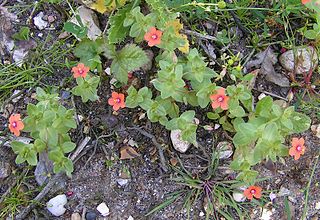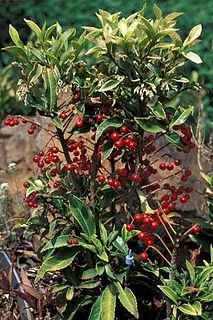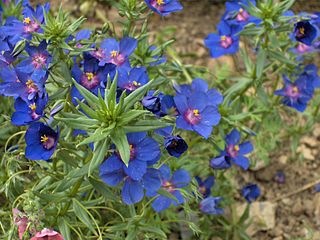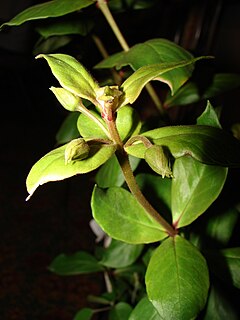
Lysimachia is a genus consisting of 193 accepted species of flowering plants traditionally classified in the family Primulaceae. Based on a molecular phylogenetic study it was transferred to the family Myrsinaceae, before this family was later merged into the Primulaceae.

Lysimachia nemorum, the yellow pimpernel, is a perennial flowering plant in the family Primulaceae.

Anagallis is a genus of about 20–25 species of flowering plants in the family Primulaceae, commonly called pimpernel. The scarlet pimpernel referred to in literature is part of this genus. The botanical name is from the Greek ana and agállein, and it refers to the opening and closing of the flowers in response to environmental conditions.

Myrsinoideae is a subfamily of the family Primulaceae in the order Ericales. It was formerly recognized as the family Myrsinaceae, or the myrsine family, consisting of 35 genera and about 1000 species. It is widespread in temperate to tropical climates extending north to Europe, Siberia, Japan, Mexico, and Florida, and south to New Zealand, South America, and South Africa.

Lysimachia monelli, the blue pimpernel or garden pimpernel is a species of flowering plant in the family Primulaceae, native to the Mediterranean region. It is not to be confused with Lysimachia foemina, which has very similar blue flowers, but broader leaves and can be found also in colder climates. In a comparison of DNA sequences, L. monelli was shown to be most closely related to L. foemina. The latter had been thought by many to be closest to L. arvensis, and some authors had even included L. foemina as a subspecies of L. arvensis. The three species were among several transferred from Anagallis to Lysimachia in a 2009 paper.

Lysimachia maritima is a plant species belonging to the family Primulaceae. It was previously called Glaux maritima, the only species in the monotypic genus Glaux. The species has a number of common names, including sea milkwort, sea milkweed, and black saltwort.
Hesperomannia (island-aster) is a genus of flowering plant in the family Asteraceae.

Lysimachia asperulifolia is a rare species of flowering plant in the Primulaceae known by the common name rough-leaved loosestrife and roughleaf yellow loosestrife. It is endemic to the Atlantic coastal plain in North Carolina and northern South Carolina in the United States, where there are 64 known populations. It is a federally listed endangered species of the United States.

Lysimachia daphnoides is a rare species of flowering plant in the Primulaceae known by several common names, including Pacific loosestrife, lehua makanoe, kolekole lehua, and kolokolo kuahiwi. It is endemic to Hawaii, where there are only three populations remaining on the island of Kauai. It was federally listed as an endangered species of the United States in 2010.

Lysimachia filifolia is a rare species of flowering plant in the Primulaceae known by the common name Wailua River yellow loosestrife. It is endemic to Hawaii, where there are two populations on Oahu and one on Kauai. It is a federally listed endangered species of the United States.

Lysimachia iniki is a rare species of flowering plant in the family Primulaceae known by the common names Wailua River yellow loosestrife and Wailua River island-loosestrife. It is endemic to Hawaii, where there is only one known occurrence existing on the island of Kauai. The plant was federally listed as an endangered species of the United States in 2010.

Lysimachia maxima is a rare species of flowering plant in the family Primulaceae known by the common name Pelekunu Trail yellow loosestrife. It is endemic to Hawaii, where there are only two small populations remaining on the island of Molokai. It is federally listed as an endangered species of the United States.
Lysimachia pendens is a rare species of flowering plant in the family Primulaceae known by the common name broad-leaf yellow loosestrife. It is endemic to Hawaii, where there is a single occurrence known on the island of Kauai. It was federally listed as an endangered species of the United States in 2010.
Lysimachia scopulensis is a rare species of flowering plant in the family Primulaceae known by the common name shiny-leaf yellow loosestrife. It is endemic to Hawaii, where there are two small populations on the island of Kauai. It was federally listed as an endangered species of the United States in 2010.
Lysimachia venosa is a rare species of flowering plant in the family Primulaceae known by the common name veined yellow loosestrife. It is endemic to Hawaii, where it is known only from the island of Kauai. The plant was only collected twice, last in 1911, but in 1991, a branch was discovered that had broken off the steep cliffs above the headwaters of the Wailua River. The branch was from a plant of this species and may have fallen from the summit of Mount Waialeale. No more specimens have been found since and the plant may be extinct, but some experts believe it may still exist in unsurveyed parts of the habitat. It was federally listed as an endangered species of the United States in 2010.
Melicope lydgatei is a rare species of flowering plant in the citrus family known by the common names Koolau Range melicope and Lydgate's pelea. It is endemic to Hawaii, where it is known only from the Koolau Range on the island of Oahu. It is a federally listed endangered species of the United States. Like other Hawaiian Melicope, this species is known as alani.

Phyllostegia parviflora is a rare species of flowering plant in the mint family known by the common name smallflower phyllostegia. It is endemic to Hawaii, where it is known from Maui, Oahu, and the island of Hawaii. It is a federally listed endangered species of the United States.
Pteris lydgatei is a rare fern species in the Pteridoideae subfamily of the Pteridaceae. It is known by the common name Lydgate's brake and is endemic to Hawaii, where it is known from the islands of Oʻahu, Molokaʻi, and Maui. It was once thought to be extinct until it was rediscovered in the 1990s. There are fewer than 40 individuals in the wild. This is a federally listed endangered species of the United States.
Schiedea lydgatei is a rare species of flowering plant in the family Caryophyllaceae known by the common name Kamalo Gulch schiedea and Pacific schiedea. It is endemic to Hawaii, where it is known only from the island of Molokai. It is threatened by the degradation and destruction of its habitat. It is a federally listed endangered species of the United States.
Schiedea sarmentosa is a rare species of flowering plant in the family Caryophyllaceae known by the common name cliff schiedea. It is endemic to Hawaii, where it is known only from the island of Molokai. It is threatened by the degradation and destruction of its habitat. It is a federally listed endangered species of the United States.











